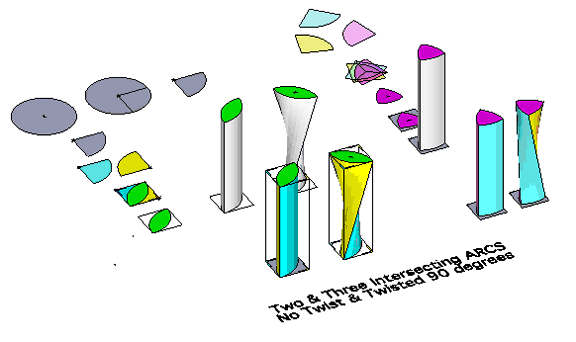Visualizing the relationship between multi-center pairs of centers and their resulting turned surfaces is tricky. With single axis turning, you're doing round cross sections and the results can be seen by watching the profile change as you turn wood off the blank . With multi-axis turning, you're turning into "shadows" and only removing wood in parts of the spinning, shadowy outline. You're also only seeing PART of the final result since you're working with INTERSECTING ARCS rather than round cross sections - and turning only one of those arcs at a time. Where ARCs intersect can only be seen once the piece stops spinning and removing wood on one arc will change where it interescts a contigous arc or contigous arcs in the case of three intersecting arcs.
Things get even more interesting, and difficult to visualize, when you add a quarter twist to a multi-center turning. You get the twist by rotating the centers on one end 90 degrees, relative to the centers on the other end of the blank.
Trying to illustrate multi-center Cause & Effect with a 2D illustration sort of works, but 3D models do a much better job. Thanks to Google's SketchUp, a free "3D" application available for both the Mac and Windows operating systems, 3D models of two and three ARC multi-center turnings can be played with in virtual 3D (actually 2 1/2 D since your seeing the 3D models displayed on a 2D screen). You'll need to have SketchUp to play with the downloadable SketchUp models in this article. Click Here to download a FREE version od SketchUP. If you only want to VIEW SketchUp models, Click Here to download a FREE version of the SketchUp Viewer.
If you're not familiar with using SketchUp or SketchUpViewer CLICK HERE for a quick and dirty Newbie Intro To SketchUp. When you're done on that page, close that window to get back here.
What follows relies heavily on Barbara Dill's papers and articles on Multi-Axes Turning. You can download Barbara's excellent papers on multi-axes turning by Clicking Here. She also has had articles on multi-axes turning published in the American Association of Woodturners (AAW) journal - American Woodturner.
Let's begin with four simple models that show the basics of between centers multi-axes spindle turning - focusing on the axis / axes.
Example 1 is the familiar single axis, centered on both ends of the blank.
Example 2 has two axes with a common center on one end and offset on the diagonal centers on the other end.
Example 3 has two PARALLEL TO THE LATHE'S Axis AXES on the diagonal of the blank.
Example 4 also has two axes but each has its centers on opposite diagonal. Look at the RED EDGES of Examples 3 & 4. If you rotate the centers on the top of Example 3's blank 90 degrees counter clockwise you'd have Example 4. This rotation introduces a NewTwist - literally - as we will soon see.

AxesTypes.skp (896K)
With single axis turning, you usually turn Full Round - the ROUND of Round and Brown. Slice through a single axis Round and Brown piece square to its axis and you'll get a ROUND cross section. With Round and Brown, the profile of the piece is always the sameas you walk around it or turn it in your hand.
With multi-axes turning, you don't HAVE TO turn to full round, though you can if you want to keep some of what's familiar. With multi-axes, you have ARCS you can play with - just part of Round. When you have multiple ARCS to play with, you've got SIDES and WHERE THEY INTERSECT to play with. As you walk around a multi-axes piece, or rotate it in your hand - the profile changes. And if you add a TWIST the profile changes even more (but we'll get to THAT shortly).

With Intersecting Arcs in mind, let's look at two and three Intersecting Arcs, with Parallel and Twisted axes. I've included the steps (back to front) used to create these virtual 3D models. This will make more sense if you download and play with the corresponding SketchUp file (Click on the image to download its SketchUp file)

2n3Arcs_Parallel_n_Twisted.skp (224K)
This next file gets into what happens when you increase the radii of the arcs. The longer the radii of the arcs the flatter the "sides". (click on the image to download the SketchUp file).

2Arcs3Arcs.skp (1.3 Mb)
As you can see, playing with intersecting arcs can get pretty interesting - with lots of design possibilities. But the idea of using ARCS has other possibilities - when applied to faces and ends.

All this stuff just hints at the possibilities multi-axes turning can bring to your turning repertoire.
Having seen Barbara Dill's Multi-Axes turned Tea Pot and Cups on the cover of the December 2011 AAW's American Woodturner magazine, I embarked on creating SketchUp models of the process for turning a Dill-esque Multi-Axes Tea Pot. To see how that one went, CLICK HERE.
If you have questions about this stuff, or suggestions on how to improve it, PLEASE e-mail me - charlieb@accesscom.com.